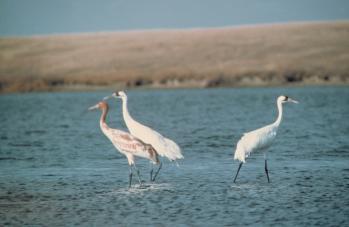
Cranes are long-legged, long-necked omnivorous birds found in water-edge and grasslands habitats throughout the world, except for South America and the Antarctic. Although they look very similar to herons and storks, they are more closely related to rails. They are usually grey or white in plumage, often with red patches of skin or feathers on the head. They have elaborate “dancing” behaviours, which have often been imitated by the people who live near the cranes. They are ground-nesters, having small broods of one or two eggs. There are 15 species of cranes (Family Gruidae, Order Gruiformes); two of these occur in North America, including Saskatchewan. Many of the crane species are considered to be vulnerable or endangered.
The Whooping Crane (Grus americana) is the largest bird which occurs in the province and is the tallest bird on the continent, at 130 cm. This tall white bird with black wingtips and red forehead and cheek bred in the province before the end of the 19th century but is now only a rare, but regular, transient between its breeding grounds in northern Alberta and the wintering grounds along the Texas coast. It can be seen in migration in the centre of the province, particlularly around the north end of Last Mountain Lake. The Whooping Crane was once found widely within the central regions of North America. By the 1940s, the population had been reduced by hunting and the drainage of its beeding sites to around 15 birds. Heroic efforts to conserve it from extinction have resulted in the present population of about 160 birds. The threat of the loss of this stately species, along with other significant species such as the Bison, have given impetus to the conservation movement, which is concerned with the health of the natural world, including individual species such as this crane.
The Sandhill Crane (G. canadensis) has much larger populations, but is also under pressure from habitat loss. The Sandhill Crane is somewhat smaller than the Whooping Crane, but is still a tall bird of over a metre in height. The grey adult has a red crown, while the juveniles are sandy in plumage. The species is presently a rare breeding bird at several marshes, scattered throughout the province. These local breeding birds are joined by large numbers of Arctic tundra breeders to form the large migrant flocks which are so visible, particularly in the fall. These large flocks stop to feed at several places in central Saskatchewan, such as the Quill lakes and Last Mountain Lake, providing a natural spectacle.
Lorne Scott, Diane Secoy